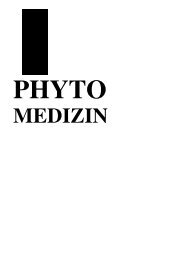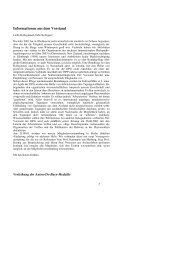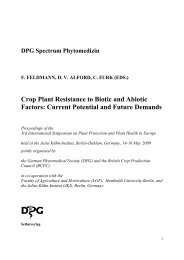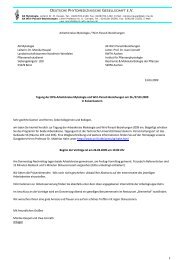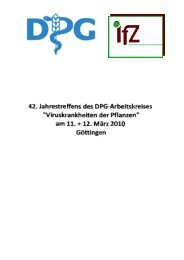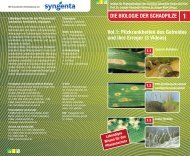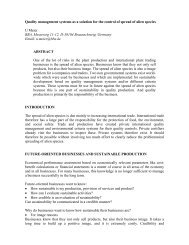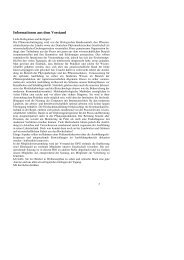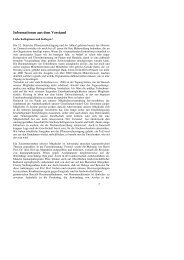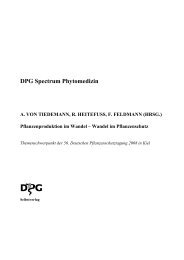PHYTO MEDIZIN Mitteilungen der Deutschen ... - Die DPG
PHYTO MEDIZIN Mitteilungen der Deutschen ... - Die DPG
PHYTO MEDIZIN Mitteilungen der Deutschen ... - Die DPG
Erfolgreiche ePaper selbst erstellen
Machen Sie aus Ihren PDF Publikationen ein blätterbares Flipbook mit unserer einzigartigen Google optimierten e-Paper Software.
phyll cells of agroinfiltrated leaves to a high extend. Agroinfection did not<br />
lead to an extension of the BMYV host plant spectrum compared to that<br />
previously described in the literature and mainly determined by aphid transmission<br />
of BMYV. Immunological investigation of agroinoculated plant<br />
tissues of N.tabacum cv. ‘Xanthi', N. occidentalis, N. rustica and Chenopodium<br />
capitatum revealed local virus infections in infiltrated mesophyll<br />
cells. However, in these plant species no systemic BMYV infection could be<br />
detected. Moreover in some plant species like N. glutinosa or N. edwardsonii<br />
neither infected plant tissue in agroinfiltrated leaf areas nor a systemic<br />
BMYV spread was detectable. Provided that BMYVfl reaches the phloem<br />
tissue in all tested plant species the method of BMYVfl-agroinfection is a<br />
easy to use procedure to determine local and systemic infectable, local but<br />
not systemic infectable or non-host plants of BMYV.<br />
Epidemiological developments in Potato virus Y<br />
M Verbeek, RAA van <strong>der</strong> Vlugt, C Cuperus and PGM Piron; Plant Research International<br />
BV, Wageningen<br />
Potato virus Y (PVY) is still responsible for important losses in ware potato<br />
production and seed potato quality. In the Netherlands a control system is in<br />
place that is based on monitoring virus infections in the field and flight data<br />
of a selected group of aphids. From these data foliage destruction dates are<br />
determined in or<strong>der</strong> to prevent tuber infection. Of the three PVY strains,<br />
PVY O (old), PVY C (common) and PVY N (new), PVY N is generally consi<strong>der</strong>ed<br />
to predominate. However, recent research revealed that PVY O and PVY C<br />
are more present than generally assumed. Based on earlier research the green<br />
peach aphid (Myzus persicae) is consi<strong>der</strong>ed the most efficient vector of PVY.<br />
As determined from trap data, the population of M. persicae appears to decrease<br />
in the Netherlands, however, problems with (primary) PVY infections<br />
persist. No data are available on the relative efficiency of PVY transmission<br />
of different field isolates (clones) of M. persicae or the role of other aphid<br />
species. To investigate whether efficiencies of different clones of the major<br />
vector of PVY are of the same or<strong>der</strong> or not, potato fields were sampled for M.<br />
persicae and strains of PVY. Transmission experiments were carried out with<br />
the wild and the laboratory clones of M. persicae from potato to Physalis<br />
floridana with two virus strains: PVY N and PVY O . A great variability was<br />
observed between the aphid clones in transmission efficiency. For example:<br />
two clones were not able at all to transmit PVY O , whereas one clone infected<br />
P. floridana with PVY N for 100%. These results indicate a relationship between<br />
the origins of M. persicae and its capability to transmit Potato virus Y.<br />
46



